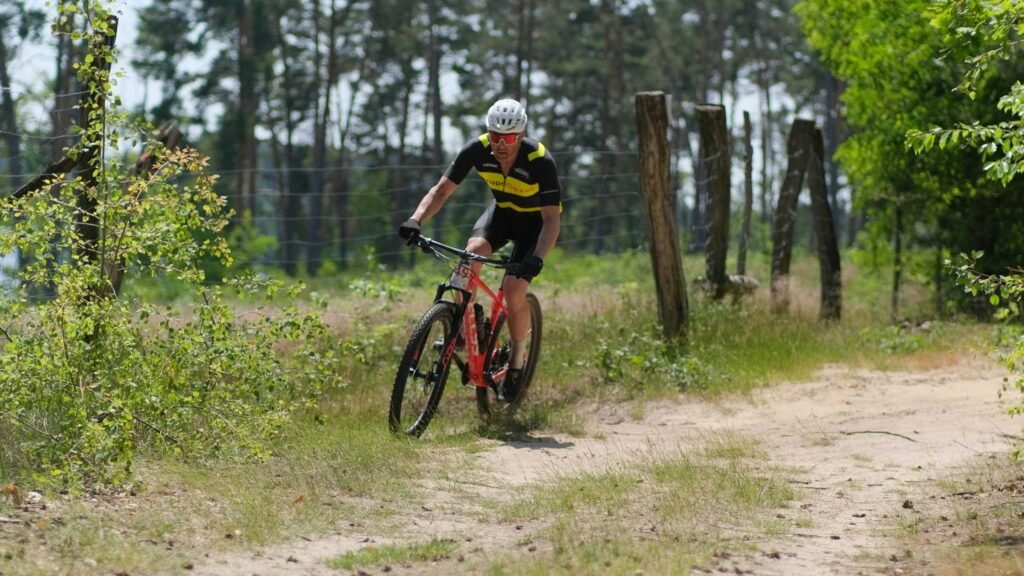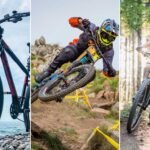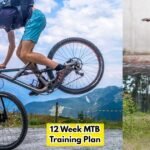Thinking, “Is mountain biking hard?” YES! Mountain biking is hard and challenging at first, but not impossible.
In fact, once you learn the basics and build a little confidence, it will become one of the most fun and addictive sports you’ll ever try.
Why Does Mountain Biking Feel Hard for Beginners?

You sit on the bike, the trail looks simple… but 10 minutes later, your lungs will be on fire, your legs will start crying, and much more.
That’s exactly how I felt in my first rides.
But, here is what usually makes it tough at the start:
- Fitness level isn’t there yet: If you don’t cycle often, your endurance isn’t ready. Climbing small hills will feel like Everest.
- Bike control feels awkward: A mountain bike is not a road bike. It’s heavier, it bounces, and it demands that you stay alert.
- Fear factor: You see roots, rocks, and narrow tracks. Your brain screams, “Don’t crash!” so you tense up, which ironically makes it harder.
- Gear shifting confusion: Front gears, rear gears, low/high ratios… the first week, you’ll either be in the wrong gear or shifting too much.
But remember, every beginner faces this. I did it, my brother did it. But if you stay consistent, in just a few weeks you’ll already feel like you’ve leveled up.
What Makes Mountain Biking Easier Than You Think
Now let me tell you the other side—the side nobody talks about when they say “MTB is too hard.”
- You control the pace: Nobody will force you to ride black diamond trails. YOU SHOULD start with flat dirt or green trails and progress slowly.
- Your body adapts fast: After 4 to 6 rides, you will be able to breathe easier, your legs won’t burn as much, and climbing feels less scary.
- Modern bikes help you: Suspension, wide tires, and hydraulic brakes? They exist to make riding smoother, not harder. However, I didn’t learn with modern bikes.
- The MTB community is welcoming: Apps like Trailforks and local clubs make it easy to find beginner trails and group rides.
So yes, it’s hard and challenging, but the sport itself has a built-in “learning curve” that welcomes you step by step.
The Physical Side – Why Beginners Struggle

These are the reasons you might struggle as a beginner when starting mountain biking.
Stamina and Endurance
One of the biggest reasons beginners quit is stamina. You ride for 20 minutes and you’re already gasping. Totally normal.
So what can you do to fix that?
I recommend that you start with something small.
Even 30 minutes of easy pedaling daily changes your game. (I wrote more about this in what happens if you bike every day for 30 minutes.)
Upper Body Fatigue
Your arms, shoulders, and core aren’t used to controlling a bouncing bike.
That’s why after the ride, your wrists will hurt, or your back will feel stiff. Push-ups, planks, and just more riding fix this.
Leg Power
MTB = legs. Squats, lunges, or just consistent trail riding will build the strength.
No need for fancy gym programs in the beginning.
If you want to go deep into stamina and power, check my guide on building stamina for longer MTB rides.
The Mental Side – Bigger Than You Think

Honestly speaking, your brain is your biggest enemy at the start.
- Fear of falling: You’re gonna fall, meme, trust me. I broke myself many times when leveling up (on downhill). But guess what? I learn to handle falls, and get smarter every ride.
- Trail anxiety: Watching other riders fly past will also make you feel slow. So my method is to ignore them. Ride at your own pace.
- Motivation dips: The first weeks are frustrating. You might think, “This isn’t for me.” But once you push past that, the love for MTB becomes unstoppable.
How to Make Mountain Biking Easier as a Beginner
Here’s the step-by-step way to reduce the “hard” and enjoy more:
1. Start With the Right Trails
Don’t jump into expert terrain. Use green-rated beginner trails on apps like Trailforks. Or just start on gravel paths and parks.
They will help you build confidence safely.
You can also check my write-up on the best age to start mountain biking, which includes tips on starting slow.
2. Pick Beginner-Friendly Gear
- Bike: Hardtail mountain bikes are perfect starters. Simple, lighter, affordable.
- Pedals: Go with flat pedals at first. Way less scary than clipless (see my comparison here: clipless vs flat pedals).
- Safety gear: Helmet, gloves, padded shorts, knee protection. Trust me, these make you braver.
3. Learn Basic Skills
Practice braking (front vs rear balance), shifting gears smoothly, and cornering with your body, not just handlebars.
Even practicing in a parking lot helps a lot.
4. Ride More, Not Harder
Consistency is everything. Even 2 short rides per week are better than 1 big monthly ride.
5. Hydrate and Fuel
Water + a banana or small snack is enough for short rides.
Don’t underestimate this. Low energy = harder ride.
The Fun Side Nobody Warns You About

You know what’s funny? At first you will fear the mtb sport, but soon you will be addicted to it.
- Climbing your first hill without stopping will feel like winning a medal.
- Descending your first rocky trail will make you scream out loud (in a good way).
- It’s one of the best joint-friendly exercises out there, better than running.
- Plus, the outdoors, fresh air, and new trails make every ride different.
This is why people stick to MTB—it’s not just about fitness, it’s about fun.
How Long Before MTB Stops Feeling “Hard”?
I’ll be honest with you: it depends. But generally, this is what I’ve seen:
- After 2–3 weeks: Bike control will feel better, and breathing will improve too.
- After 6–8 weeks: trails that scared you before now look manageable.
- After 3–6 months: You’ll ride with flow, confidence, and even handle small jumps or technical sections.
Consistency always wins. If you keep showing up, the “hard” side fades fast.
Mistakes Beginners Should Avoid
Being a beginner, keep all these things in mind and follow them.
- Starting on the wrong trails: Too advanced = frustration.
- Ignoring bike setup: You want to check the saddle height, check tire pressure, and brake check. I also recommend you do a pre-ride checklist.
- Not wearing gear: Even small crashes will hurt when you’re not wearing helmets and other MTB Gears.
- Pushing too hard too soon: Progress slowly, don’t chase others.
- Skipping recovery: You should do stretching at home, take proper rest, and fuel up. MTB isn’t only about the ride; your off-bike routine matters too. When you’re too tired, before sleeping, you can drink Anti Inflammatory Hot Chocolate.
From Beginner to Confident Rider
Once you stick with it for a few months, you’ll notice something: mountain biking doesn’t feel “hard” anymore—it feels exciting.
The same hills that made you walk your bike before will now make you proud when you ride them up.
The same descents that scare you will feel like roller coasters.
That’s the beauty of MTB—you grow with it. There’s always a new challenge waiting, but at the same time, you’re never “too late” or “too weak” to enjoy it.
Conclusion
So, is mountain biking hard for beginners? Yes, in the start, it will test you. Your legs will burn, you’ll fight with gears, your heart will race, and fear will mess with your head.
But step by step, ride by ride, the hard part fades and the fun part grows. You’ll get stronger, more confident, and honestly—you’ll surprise yourself with what you can do on a bike.
Mountain biking isn’t about being perfect or fearless from day one. It’s about showing up, learning slowly, and enjoying the trail as it comes.
If you keep riding, in a few months you won’t be asking “is MTB hard?” anymore… you’ll be telling others how awesome it feels.
So, grab your bike, pick a simple trail, and start. The first ride will feel tough, but the future rides will feel worth it.
FAQs
Let’s discuss some questions real quick.
How long does it take to get good at mountain biking as a beginner?
It depends on how often you ride. If you ride 2–3 times a week, you’ll feel major improvements in 4–6 weeks.
After 3 to 6 months, your stamina and skills will be on a different level. The key is consistency, not talent.
Do I need to be very fit before starting mountain biking?
Not at all. MTB itself builds your fitness. Start with easy trails and short rides, like 30–40 minutes, and your endurance will grow.
If you want extra help, simple exercises like squats, push-ups, and core workouts will speed it up.
Should beginners use flat pedals or clipless pedals?
Flat pedals, always. They’re safer, you can put your foot down instantly, and they build your confidence.
Once you’re experienced, you can test clipless. I explained this more in my clipless vs flat pedals guide.
What’s the best type of bike for a beginner mountain biker?
I recommend you go with a hardtail mountain bike as a beginner. It has front suspension only. And that’s why it’s lighter, cheaper, easier to maintain, and perfect for learning skills.
However, when you gain more experience, you can get a full suspension if you want more comfort on rough trails.

Ali is the founder of Mountain Bike Insider and an passionate rider with years of hands-on experience in mountain biking. From testing gear to exploring trails, Ali writes based on real riding knowledge to help others make smart, safe, and enjoyable biking choices. Every guide is built on research, personal use, and a passion for the sport.







